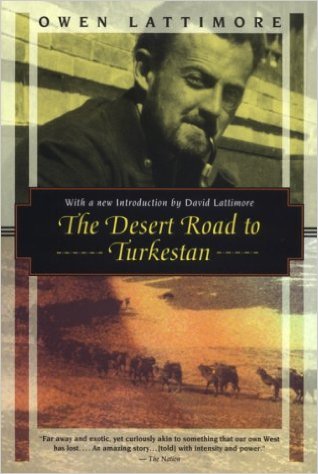 Last night, I dug out the only Owen Lattimore book I own – 1928 The Desert Road to Turkestan.
Last night, I dug out the only Owen Lattimore book I own – 1928 The Desert Road to Turkestan.
Of all the adventurers on the Silk Road I discovered during my researches, Lattimore is probably the one I have more dear.
Maybe it’s because he was subject to much injustice, or because he was a keen observer and a charming storyteller.
Owen Lattimore was born in the USA in 1900. He was raised in China and educated in Switzerland and England. Unable to afford a university education, he got back in China, studied Chinese and was employed by a British commercial firm as jack of all trades and troubleshooter.
A load of wool blocked somewhere in the wild at the whim of a warlord? Send in Lattimore.
He actually liked it.
Traveling through Central Asia on behalf of his company allowed young Owen to explore and take notes, and meet people. He was quite popular with the herders, nomads and camel-drivers, who claimed they could recognize him from a distance by the sun sparkling on his monocle.
In fact, his penchant for doing extracurricular activities while out on a mission for his bosses was what got him fired in the end – the company did not like the idea of Owen taking a few hours off, while traveling with a camel train, to explore some ancient ruins or what.
Bad for business.
But before they fired him, they grounded him – and while he was grounded, riding a desk in Beijing, his job expiring in a few months, Owen met a girl, Eleanor Holgate, and they got married. It was 1927.

To quote from Wikipedia…
For their honeymoon they planned to travel from Beijing to India, he overland, she by rail across Siberia, a mammoth feat in the first half of the 20th century. In the event, the plans were disrupted and she had to travel alone by horse-drawn sled for 400 miles (640 km) in February to find him.
It’s a little more complicated that that: Owen was presumed dead when his wife started her winter crossing to go and find him. And The Desert Road to Turkestan was Lattimore’s diary of the first leg of that quite adventurous honeymoon trip1.
 There’s a lot more to Owen Lattimore’s story – his work in Asia and in America, his missions on behalf of F.D. Roosevelt after the Second World War broke up, and his trial during the McCarthy witch-hunts – when he and his wife were accused (on very flimsy and dubious evidence) of working as spies for the Russians. Maybe we’ll talk again about all that.
There’s a lot more to Owen Lattimore’s story – his work in Asia and in America, his missions on behalf of F.D. Roosevelt after the Second World War broke up, and his trial during the McCarthy witch-hunts – when he and his wife were accused (on very flimsy and dubious evidence) of working as spies for the Russians. Maybe we’ll talk again about all that.
During his life Owen Lattimore wrote a body of works about China and Central Asia that was, and remains, highly influential.
But the reason why I dug out my copy of Lattimore’s first book – and why I tried to locate a cheap copy of its follow-up, 1930’s High Tartary2 – is because while reading both Ella Maillart and Peter Fleming, Lattimore’s name was mentioned as that of the last Westerner to visit and travel through Chinese Turkistan, and his book was used as a reference by the two travellers we are about to follow.
Because after Owen Lattimore, for eight years, no foreigner was able to get in – or out – of Tartary, where civil war, natural disaster and pestilence held sway. But we’ll talk about that, too.
So there – as we’ll try and follow the footsteps of Maillart & Fleming, they were trying to follow – at least ideally – the tracks of Owen Lattimore.
So I thought I’ll keep his work handy.
- I do have a copy of Eleanor Lattimore‘s Turkestan Reunion, which tells her part of the story. She’ll be close at hand, too, during our adventure. ↩
- and I found it! And should be here in a few weeks. ↩

